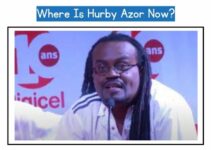Be you a performer, a session player, or a studio engineer, reverbs are one of those things you should have in your sonic arsenal. Reverbs just make things sound better (not exactly the case with all bass instruments).
Acoustically, reverb makes things easier and more pleasing for the human ears. It simulates acoustic conditions that are likely out of the reach of the performer or engineer at that point in time.
Imagine sounding like you are in Abbey Road Studios while actually rehearsing in the comfort of your garage.
Also, imagine sounding like you are in a million Dollar cathedral with some awesome architecture and wooden ceilings. Reverbs can make this all possible.
Reverbs will mask playing, recording and mixing imperfections. In summary, reverbs just take your sound to an entirely new sonic level. In most cases, you can never go wrong with the right reverb.
Apart from vocals, guitars, and keys, synth sounds also benefit a whole lot from some reverb.
The right reverb will not just make your synth smoother and more cohesive, but it will also make your synth sound bigger by giving it an awesome sense of space.
We have both software and hardware reverbs. What you choose will be determined greatly by factors like workflow, nature of musicianship, budget, etc. A player who records himself remotely could easily rely on a software reverb plugin.
However, this doesn’t mean that they cannot use actual hardware if they want to.
On the contrary, a performer who plays live on stage might find hardware more useful. This all depends on several factors. It’s not a one-size-fits-all scenario.
In this article, we will look at the best software and hardware reverbs you can possibly get for your synthesizers.
The 5 best hardware reverbs for synths that we recommend are Strymon BigSky, TC Electronic Hall Of Fame 2, Boss RV-6, JHS Spring Tank, and Source Audio Ventris Dual Reverb.
The 5 best software reverbs for synths that we recommend are MCharmVerb, FabFilter’s Pro-R, UVI Plate, Denise Audio Perfect Room, and Relab lx480 Complete.
Table of Contents
5 Best Hardware Reverb for Synths
5 Best Software Reverbs
Review of 5 Best Hardware Reverbs
Strymon BigSky
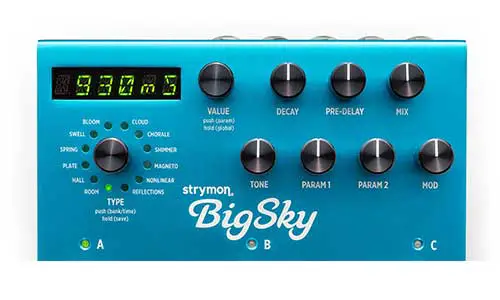
The Strymon BigSky is one of the most popular reverb pedals on the In keeping with Strymon’s reputation for providing highly practical, great-sounding guitar pedals, the Strymon BigSky is one of the most popular reverb pedals on the market. It is manufactured in the US.
Strymon’s Bigsky Reverberator remains one of our most in-demand pedals. With an outstanding palette of reverb types, this revolutionary design is still the best choice to compete with its contemporaries.
Bigsky’s tone is Bright and clear, with Lengthy reverb trails with a wide intensity range, and it also feels and sounds like an analog reverb pedal. Some of its unique features include:
- Frequency sensitivity of 20Hz to 20kHz
- 9 volts
- The maximum input level of +8dBu efficiently handles instrument and line signals
- 32-bit floating point processing
- True Bypass
- Hand power source
- High-quality, transparent Analog Buffered Bypass mode
- Dimensions: 6.75″ (171mm) wide, 5.1″ depth
- Very high-performance DSP in a small package
- 333MHz SIMD SHARC processor core
- Available in transparent, clear, and cloud colors
| Pros | Cons |
| Adjustable control | Expensive |
| Excellent reverberation | Big and heavy compared to other reverbs |
| Input and output MIDI | Hard to learn and use |
| Excellent design | It may not be compatible with all power supplies |
| Multiple onboard presents |
TC Electronic Hall Of Fame 2
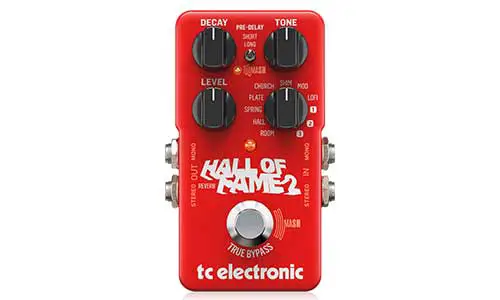
The Hall of Fame 2 Reverb Pedal is an eight-reverb, three TonePrint preset, pressure-sensitive MASH footswitch with controls for Decay, Tone, Level, and Mode.
With three new features, the Hall Of Fame 2 pedal has the same features as the original, Electronic of Fame.
Musicians looking for the tonal versatility of various reverb effects without giving up the portable pedal design are the target audience for the Hall of Fame 2.
The three TonePrint slots allow users to choose and then further customize the desired reverb texture from the eight available algorithms or to save unexpected sounds.
The Hall of Fame 2 has studio-caliber reverb settings for various tonal options; the TonePrint Editor also lets you add more.
The pedal also has two more TonePrint slots, giving you more options for employing your creative reverbs.
TC Electronic Hall of Fame 2 has a dimension of 5 x 3.5 x 3 inches and weighs 0.35 KGs.
| Pros | Cons |
| Uses Mash expression | Heavy |
| Easy to use | Underwhelming Mash Foot |
| Quality design | Need a phone or computer to change the effect type |
| Clear tones | |
| Friendly price | |
| Simple interface | |
| Has a Tiny foot |
Boss RV-6
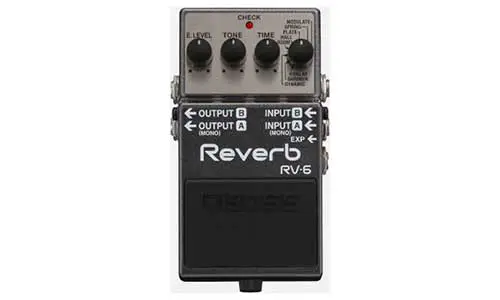
The RV-6 elevates pedal-based reverb to a new level by fusing premium sound with a wide range of adjustability.
Beyond the capabilities of previous generations, this potent stomp uses cutting-edge technology and legendary BOSS skill to make it simple to obtain great reverb tones fast.
The RV-6 surrounds your tone in rich ambient environments that excite you, from delicate chambers to modern shimmer effects to extended, powerful reverbs.
The RV-6 is a highly adaptable reverb pedal housed in a durable enclosure, making it ideal for a road trip. It offers everything from spring reverb simulation to authentic-sounding plate reverb and reverb With delay modes.
Boss provides simplicity, affordable prices, and decent but not exceptional sonic quality, as is typically the case. With this pedal, Boss demonstrates their ability to fit a surprising amount into a compact space using a reverb pedal.
When purchasing one, you can be confident that every visible and audible feature of a Boss product has been carefully thought out for the best possible performance.
Reverb models include Room, Spring, Modulate, Delay, Dynamic, Plate, Hall, and Shimmer. Some of the BOSS RV-6’s unique features include
- Reverb pedal with a small footprint and a rich, spacious sound.
- Allows either mono or stereo operation
- You can swiftly dial in intricate, top-tier reverb tones with simple controls.
- Reverb pedal with a small footprint and a rich, spacious sound.
- Control the reverb volume using an extra expression pedal.
- Studio-grade algorithms that have been newly designed and are powered by cutting-edge BOSS technology
- Width: 73 mm
- Depth: 129 mm
| Pros | Cons |
| Heavily built hence durable | Reverb and shimmer balance are not adjustable |
| Excellent tone range | Absent tone print features |
| It can be used for both performance and recording | No presents |
| Inexpensive | Some reverb sounds are familiar |
| User friendly | |
| Standard power requirement |
JHS Spring Tank
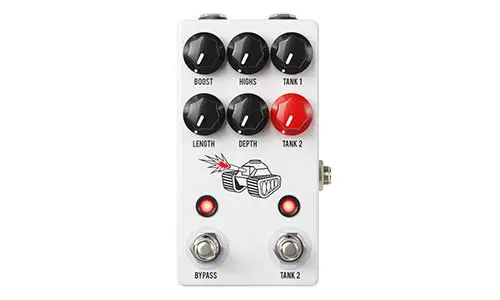
The JHS Spring Tank Reverb is a true amp-style spring reverb pedal in a small package.
It has two separate and switchable reverb mix settings, Tank 1 as the main reverb mix and Tank 2 as the secondary, activated via the Tank 2 switch. So, on the fly, you have two reverb mix options!
The pedals are Produced and assembled in Kansas City. Josh Scott delivers a dedication to quality work and practical features that give his items unrivaled value.
Josh’s greatest inspiration continues to be the musicians who rely on JHS to create their art as he continues to tinker and adapt to the evolving needs of today’s guitar players.
Because the Spring Tank contains an effects loop, you can only apply effects to the reverb tails. This allows you to create fantastic soundscapes with various effects.
Connect a TRS splitter wire to the effects loop jack and insert any pedal into the loop to get started. An internal switch allows you to turn on the effects loop only when Tank 2 is engaged or always.
| Pros | Cons |
| Has a rich organic sound | Quite pricey |
| Simple to use | |
| Has 2 reverb mixes |
Source Audio Ventris Dual Reverb
- 14-mode Dual Reverb Pedal with Favorites
- USB and MIDI Connectivity
- Mono/Stereo Operation
The Ventris Dual Reverb from Source Audio is a hardware effect pedal. It is a digital reverb machine with two independent reverb engines that may be used in series or parallel, stereo inputs and outputs, MIDI control, and other features.
While software-based reverb plugins can provide comparable capabilities, the Ventris Dual Reverb is a standalone piece of hardware intended exclusively for guitarists and other artists looking to add high-quality reverb to their signal chain.
The Ventris Dual Reverb has two separate 56-bit reverb processors, effectively housing a matching pair of high-powered reverb pedals in a single cabinet.
The robust dual-processing design of the Ventris gives the pedal some real advantages, such as huge processing muscle, customizable preset spillover duration, and the ability to produce multiple reverb effects.
| Pros | Cons |
| Simple to use | Expensive |
| Strong reverbs in a single box | Large pedal, hence requiring a large physical space |
| A variety of dual-routing options are available | Requires 300mA power |
| The reverb is fantastic | |
| Editing software is freely available | |
| Much more adaptable than other reverb pedals |
Review of 5 Best Software Reverbs
MCharmVerb
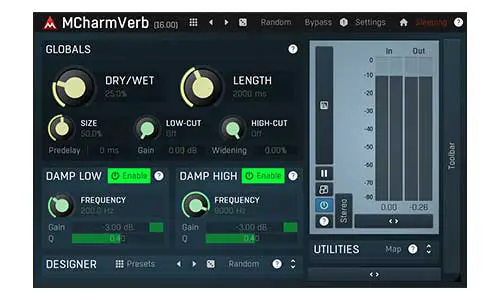
Melda Production is a company that specializes in generating software audio effects and virtual instruments. The company created MCharmVerb, a reverb plugin.
MCharmVerb is a free software reverb plugin that can be used in a computer-based digital audio workstation.
The plugin is based on the complicated MTurboReverb engine. However, it has a significantly reduced set of control settings, and this is fantastic news for people that prefer to utilize streamlined and less complicated plugins.
MCharmVerb includes the typical Reverb Size, Length, Pre-Delay settings, a Dry/Wet knob, Gain control, and a Widening slider for altering stereo width.
A pair of filters, high and low pass, are also included, as with tone controls for Damp Low and Damp High. To conserve CPU resources, the dampening modules can be disabled.
| Pros | Cons |
| Affordable | Low latency |
| Quality sound | |
| Easy to learn and use |
FabFilter’s Pro-R
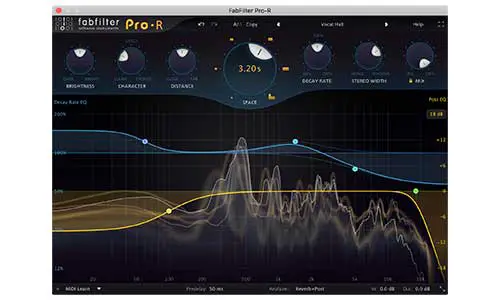
The FabFilter Pro-R interface is intended to be simple to use while offering all relevant information and settings. It is made up of the following components:
FabFilter Pro-R is a high-end reverb plugin with a natural sound, musical controls, and innovative features such as the unique Decay Rate EQ to define the reverb’s character.
Reverbs, one of the most often utilized effects in the audio world, come in various shapes and sizes.
While IR reverbs may sound believable, they could be more adaptable and are frequently so dense that they are difficult to include in a mix.
On the other hand, many computational reverbs are not rich enough, sound unnatural, or have so many technical possibilities that they are simply too complex to set up.
The reverb comes in VST, VST3, AudioSuite, Audio Units, and AAX Native formats.
Key features include:
- Has a few screen size
- Control decay rate
- Beautiful retina interface
- Lock mix option
- Has a real-time spectrum analysis
- Smart interpolation parameter
| Pros | Cons |
| Excellent customer support | Has no standalone version |
| Compatible with a wide range of operating systems and DAW | Reverb types limited |
| Easy to use | Can strain computers’ processing power |
| High-quality sound | Expensive |
UVI Plate

UVI claims its modeling engine can convincingly mimic old hardware reverbs while going beyond standard sounds and natural principles.
As a result, any number of custom-made reverb setups and a plethora of sound design possibilities are available.
Select from various metal sheets, alter the size of the plate, manually position inputs and outputs on the plate, add irregularities and stress to the metal, and then create your decay using models of the dampener, thermo-elastic loss, and air radiation.
UVI Plate, built on science and tuned by musicians, allows you complete control over the sound of your favorite hardware devices and the option to design your own.
Overall, this is an effective plug-in with cutting-edge modelling approaches that are also ingeniously structured – its sectioned graphical interface invites both novice and professional users.
| Pros | Cons |
| Has a low CPU usage | Limited genre |
| Easy to use | Expensive |
| Customized parameter | Requires DAW to use |
| Has an authentic sound | Limited presents |
Denise Audio Perfect Room
Perfect Room by Denise Audio is a software plugin that adds a natural-sounding reverb effect to audio recordings.
The plugin uses TXVerb technology, which does not employ delays to generate reverb tails. Instead, it produces a genuine acoustic space and naturally enhances the color and character of the input signal.
A mix knob for combining the dry and wet signals and a stereo width control for broadening or limiting the reverb’s stereo area are also included.
Users have commended the plugin for its ability to produce a realistic and organic reverb sound, with many remarking that it works well on various instruments and vocals.
The plugin has also been lauded for its adaptability and ability to enhance the character and color of the input signal musically.
Some users have mentioned the learning curve involved with the plugin, as it takes a different approach to reverb processing than other algorithmic reverbs that rely on delays.
Overall, the Denise Perfect Room is a well-liked reverb plugin that takes a novel approach to reverb processing and is ideal for those seeking a genuine and organic-sounding reverb effect.
| Pros | Cons |
| Beautiful reverb | Hard to learn |
| Has 3 module effects, unlike other reverbs | Unresizable GUI |
| Has an organic pure sound |
Relab lx480 complete
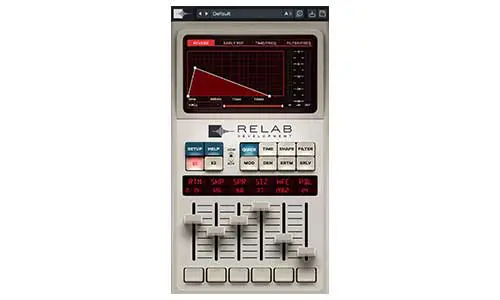
The LX480 plugin most accurately emulates Lexicon’s renowned 480L Digital Effects System.
With good cause, the Lexicon 480 is arguably the most well-known digital reverberator ever created. Even though this vintage device has been imitated a lot, its sound is still distinctive.
LX480 is available in two flavors: Complete and Essentials. The red-lit screen at the top, the bank of buttons, and the parameter control sliders that take up most of the panel’s bottom half are all striking visual echoes of the remote control panel on the original hardware.
In addition to offering what is generally regarded as one of the best reverbs ever created, the LX480 enhances the legendary 480L hardware model by adding higher density modes and other features not included in the original, essentially redefining the norm for future reverb plugins by using a historical legend.
| Pros | Cons |
| Low CPU usage | Expensive |
| Easy to use | Has a complex learning curve |
| Has a high-quality sound | Uses ilok dongle |
| Authentic emulation |
Hardware vs. Software Reverbs; How Different Are They?
Both hardware and software reverbs are made to provide fake reverberation effects to audio recordings, but there are some significant distinctions between the two.
The majority of the time, hardware reverbs are physical devices that produce reverb effects using analog circuitry or digital signal processing (DSP).
They frequently take the shape of rack-mountable devices or pedals that resemble stompboxes, and inputs and outputs allow them to be connected to a mixing desk or recording interface.
Due to their design’s specialized algorithms and processing techniques, hardware reverbs can offer a distinctive and frequently sought-after sound.
In ways that are challenging for software to replicate; they can also be utilized to color or shape the sound of an instrument or voice.
Unlike hardware reverbs, software reverbs plugins that operate on a computer or digital audio workstation (DAW).
They can offer a wide range of reverb kinds and settings, frequently with more flexibility and control than hardware machines, and they use DSP algorithms to imitate the impact of reverb in a digital context.
While they don’t need to be purchased separately and attached to a system, software reverbs can also be more affordable and available than hardware units.
The sound and operation of hardware and software reverbs differ significantly in several important ways.
Compared to software reverbs, hardware units can offer a distinctive sound that is frequently desired, but they can be more challenging to adjust and regulate.
On the other hand, software reverbs may be more flexible and controllable but may have a different warmth and personality than hardware reverbs.
The final decision between hardware and software reverbs will be based on the requirements and preferences of the specific user.
Some users could choose the sound and tactile feel of utilizing hardware devices, while others would favor the practicality and versatility of using software plugins.
Hardware or Software Reverb; Which is Best for Me?
Reverb gives your mix depth and space, but it also provides the listener with crucial cues regarding the location of the sound and its position with it.
You can use reverb to take a listener to a symphony hall, cave, cathedral, or small performing venue.
When recording voice or acoustic instruments, it is typically ideal to have the reverb as near to a real-world acoustic setting as feasible.
This frequently results in a smooth and lush reverb that accurately mimics the acoustic environment of a real physical space.
Some hardware reverbs have an immediate record-like sound and Fits properly. The 3D sound is audible from the speakers, and a much more 3D-like sound emanates.
Most software reverbs don’t; they sound more monotonous or clinical and require considerable tinkering to achieve that sound, if feasible. Other plugins from the same vendor even emulate hardware.
The software reverb is best if you require a portable reverb, though. Since you have to transport hardware reverbs, they might need to be more convenient.
Conclusion
Hardware and software reverb are both suitable tools. Reverbs improve a sound’s acoustics and make it more palatable to the human ear.
Reverbs mimic acoustic settings that the performer or engineer at that time would be unable to control.
The decision between hardware and software reverb ultimately comes down to personal taste, organizational necessity, and project-specific requirements.
While some musicians and engineers favor hardware’s direct management, others choose software’s adaptability and practicality.
These alternatives continue to expand and change due to technological developments, providing even more options and opportunities for imaginative sound design.

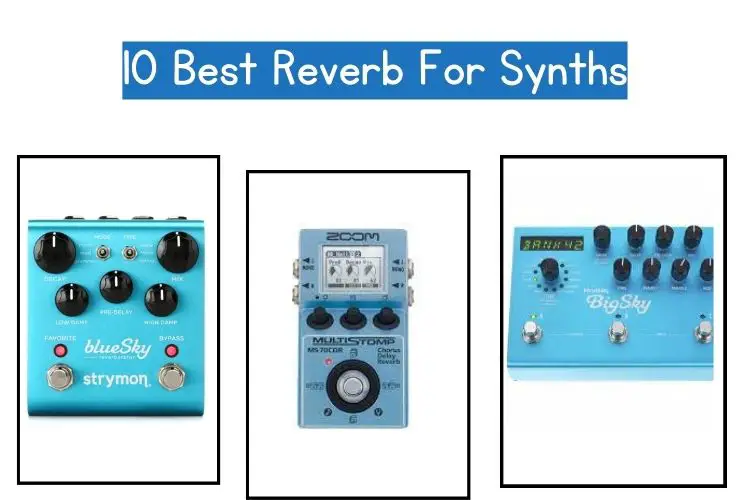


![HERE’S What Happened to the Soul Singer Al Green [2023 Update]](https://performerlife.com/wp-content/uploads/2023/04/what-happened-to-al-green-211x150.jpg)
